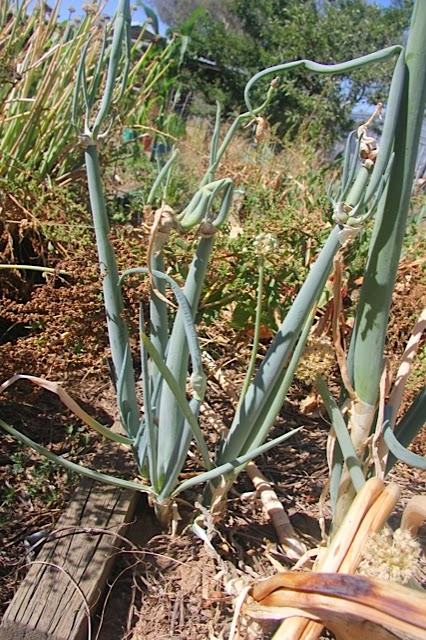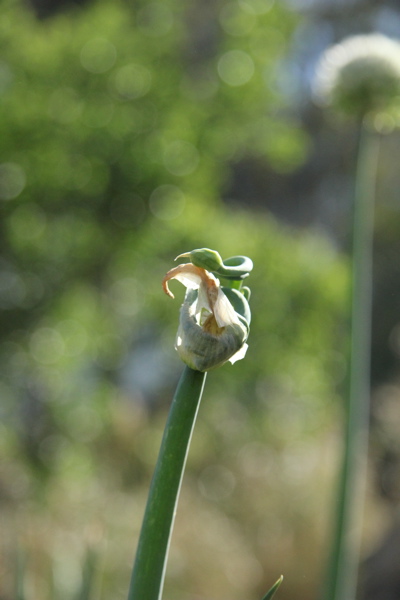I first heard about Pineapple Sage (Salvia elegans) on the internet somewhere and I was both intrigued and skeptical. Everyone who wrote about growing or eating this plant raved about how great it is. I wanted to try some but did not want to pay a fortune for one through some mail order and then find it did not smell like pineapple, or that it smelled of pineapple but the pineapple smell was overpowered by the smell of sage. I was lucky enough to find a small plant for sale in a shop somewhere and was able to smell it before buying it. It smelled delicious, just like sweet pineapple. After smelling it I had to buy one and try and grow it. I am happy to say that it was simple to grow and performed rather well even in my harsh climate.
| Pineapple sage flowers are sweet and delicious, just like the leaves |
Pineapple Sage is quite possibly my favourite herb. Many herbs are meant to smell like something, and they do if you use your imagination and wish really hard, but pineapple sage is different. Other things smell different depending on where or how they are grown, how much water they are given or even the time of day that you smell them, chocolate mint is a prime example of this. Other herbs have faint scents, or they have the scent of its name sake but it has another smell that overpowers it. Pineapple sage actually smells like pineapple. It really does. It is not a faint pineapple smell that also has a sage smell overpowering it, it smells strongly of pineapple and nothing else.
Pineapple sage, like many of the vegetables that are eaten in Australia, is native to Central and South America. It is less hardy than regular sage, frost knocks it around a bit if not protected, and it needs a little more water than regular sage, but it is still worth growing. I grow some in the garden, mulch it well and hope that when the tops get burned off by frost that the roots will survive and re-sprout in Spring. As well as growing it in the garden I always have one or two in pots, that way if we do happen to get an especially hard frost that kills off the garden grown plants I still have one in a pot to start over with when the weather warms up again. It is simple to propagate via cuttings, but they only seem to take for me during the cooler weather.
I love pineapple sage, after reading about it on the internet it seems that I am not alone in my love for this plant. I would grow it simply to smell as I walk and brush past it. Water is scarce out here so I would struggle trying to justify growing a plant that simply smells nice. Luckily it is not just a nice smelling ornamental, the whole plant is edible and useful in a number of ways.
Both the leaves and flowers of this versatile plant are edible, the leaves are used to flavour meat, poultry and other main meals, it is used in 'herbal tea', used for sorbets as well as a large range of desserts. The flowers can be added to drinks, jellies, jams, desserts and fruit salad. My kids and I like to make 'tea' by steeping the leaves in hot water and adding some honey or sugar. Even my eldest son Igloo, who is rather picky about drinking such things loves the smell and the taste of pineapple sage tea. Igloo is trying to convince me to let him grow 100 pineapple sage plants in his little vegetable garden, perhaps we will start with one and see how he goes.
Pineapple sage is meant to deter some pest insects, so I grow a few in amongst the vegetables in the garden. To be honest I do not know if it makes any real difference, but nothing seems to grow any worse by having pineapple sage next to it and it is good to have a few extra plants. By hiding it in amongst the vegetables they seem to be slightly safer from children who love to steal the leaves to eat them or do whatever it is that kids do with nice smelling leaves.
| Pineapple sage grows well in a pot or in the ground |
Pineapple sage leaves are a nice shade of green, in Autumn to Winter it will flower with beautiful red flowers. These flowers smell as delicious as the leaves and are often visited by honey bees and several other pollinators. We have seen honey bees as well as nine different species of native bees on the pineapple sage flowers, they simple adore it. By flowering in Autumn and Winter they provide food for pollinators and beneficial insects in a time when traditionally they do not have a lot of food available in this area. If you can grow it in a protected spot where the frosts will not burn it you will have it flowering most of the way through winter. This means that come Spring you have a large number of pollinators and predatory insects already living in the garden ready to pollinate flowers and take care of any insect pests that may be around.
According to the internet pineapple sage is extensively used in Mexican traditional medicine, especially for the treatment of anxiety, depression, stomach aches, evening out blood sugar and for lowering of blood pressure. I can't comment on how effective it is, but Igloo does seem a lot calmer and happier after he has drank some pineapple sage tea.
I have seen a golden leaf form of pineapple sage, apparently it is the same as regular pineapple sage but looks a bit prettier. Some day I hope to track it down and try to grow it as well, but for now I am happy with the regular pineapple sage.
If you have never grown pineapple sage you should try it. Your kids will thank you for it.





